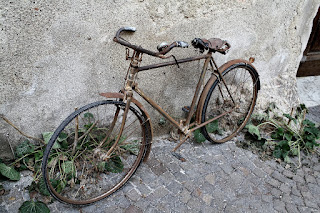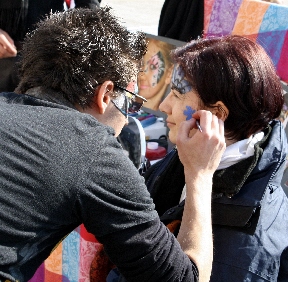Tuesday, February 28
 |
| Here are a couple of the 50 or so fruit and vegie vendors in the market. |
Previously, we have
never lived anywhere in Italy where we could walk just a few blocks to a huge
daily market. Last year in San Salvatore, we discovered a small market that
came to town just one morning a week. When we last lived in Padova, we were on
the edge of town, far from the market, and we used a neighborhood Alí grocery
store for small daily purchases. Once a week, we also took the bus or our bikes
to the larger Auchen supermarket to stock up on staples. At that time, we
passed by the huge Padova central market only occasionally, and for me it never
really sank in that this market is set up and taken down every day, except
Sunday, and that people come here each morning to buy the food they plan to
prepare for that day.
The selection is vast
and diverse. I walk up and down the aisles and count nearly 50 separate fruit
and vegetable vendors, each with a tent set up over box upon box of fresh, ripe
produce. I usually do not linger as I do today, and by taking some extra time,
I notice that the prices are a little lower in the center of the aisles. I have
always bought from the first stall I came upon, but now I see that the outside
vendors, with their more convenient locations, can get away with charging more
because of people like me. I also notice that the center rows are packed with
Italian shoppers who already know where to find the better prices.
 |
| This is a bean lovers dream. |
I go back to the
vendor where last week we bought some soup mix. I really don’t know what this
stand is called in either Italian or English, but it has a beautiful and
mouth-watering array of every type of bean, rice and pea, along with many grains
and other dried ingredients. They are in burlap sacks, but the tops of the
sacks have been turned down to display the wares. It would take a lifetime to
learn the best use for all these foods, so for our soup last week, we settled
on zuppa golosa, a pre-mixed variety
of orzo, farro, lenticchie, piselli and fava. Today we buy another kilo of zuppa golosa and also some mixed beans.
I ask the lady who serves us how many types of beans this combination contains.
“Tanti,” she says with a quick smile. “Tutti.” So many. All. I
count the individual bean varieties on sale and find about 30, so I guess we
will be having 30-bean soup soon. I also count 12 types of risotto, and then another
12 types of risotto mixed with various other individual items, such as dried mushrooms,
dried vegetables, spices, beans and even fruit. Other bins have similar varieties
of basmati and couscous.
Much of it I have no
idea how to prepare. Lucy, of course, does most of our cooking and is an
excellent cook, with years of experience and no reluctance to experiment or use
a cookbook to try something new. Yet even with all her expertise, she admits to
being overwhelmed and somewhat bewildered by some of the new and unfamiliar ingredients. We need a personal trainer to teach us how to shop and use everything the market has to offer.
Next to the outdoor
stalls are vendors with more permanent locations, under cover and with
electricity needed to keep their meats, poultry and cheeses chilled. There are
nearly as many butcher shops inside as there are produce vendors outside. The
cheese choices are truly daunting. I ask a vendor how many different types of
cheese he has. Only about 140 here, he says, because he doesn’t have enough
room for all the others he could stock. How is one to know which to serve with
which type of meal?
 |
| When they say whole chickens for sale, they're not kidding. |
One macceleria has
defurred rabbits and whole chickens and turkeys hanging from the ceiling, but
most meat is already cut up and labeled. Perhaps some Italians want to see the
whole animal to make sure they are getting the real thing. My mom used to use
rabbit meat in pasta asciutta, and it was delicious, but we don’t feel at ease
buying a whole or even half rabbit.
A couple of markets
specialize in horse meat. No thanks on that, too, although apparently I have
eaten it before. I once made a comment that I have never tried horse meat, and
Patti Gray said, “But didn't you eat lunch at the school? They serve horse meat
sometimes.” Yes, when I taught for a year at EISP, I ate lunch in the cafeteria
every day, so apparently I’ve had horse meat without knowing it. Still, I am
not interested in trying it again.
 |
| The easiest and cheapest way to eat great Italian food is to buy fresh pasta and fresh sauce, then put it together in your own kitchen. Even I can do this! |
So though we only
scratch the surface of the Italian menu possibilities, the choices we make are
more than satisfactory. We can easily buy fresh pasta in nearly infinite
varieties, and the sauce choices are also plentiful. Some shops offer freshly
cooked pasta dishes which can be taken home and reheated in the microwave. The
strawberries and oranges we buy today take no special skills to prepare and
eat.
 |
| Here's another way to eat cheaply without knowing how to cook. Buy it ready-made. |
True, modern
supermarkets are easier and more familiar for us, but shopping in the open
market is a priceless experience. Italians have bought their food this way for
thousands of years, and we feel in a small way we are now part of that history.














